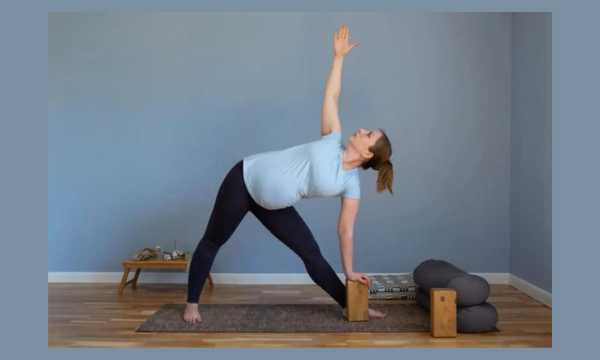For many expectant mothers, yoga is a valuable practice that can provide relaxation and well-being during this phase.
Ad
During pregnancy, many women look for ways to take care of their body and mind, and yoga is a practice that offers these benefits in an integrated way.
In addition to promoting relaxation, help alleviate physical discomfort, improve posture and strengthen your bond with your baby.
Ad
If you are pregnant and want to explore how yoga can be part of your journey, check out the tips and guidance to make the most of this practice during this special period.
1.What Are the Benefits of Yoga During Pregnancy?
Regular yoga practice during pregnancy offers a range of benefits for both the mother and the baby. Among these, we can highlight:
Ad
- Relaxation and stress reduction: The breathing and meditation techniques help control anxiety and promote relaxation, providing a sense of well-being. The practice can improve sleep quality and assist in managing emotions, contributing to a more peaceful pregnancy.
- Pain relief: Alleviate common pregnancy pains such as backaches, leg pain, and joint discomfort through stretches and specific postures.
- Muscle strengthening:Help strengthen body muscles, preparing the mother for childbirth and assisting in postpartum recovery. Strengthening core and pelvic muscles can facilitate labor and recovery after birth.
- Improved circulation: The inverted positions and gentle movements of yoga stimulate blood circulation, providing more energy and vitality. This can reduce swelling in the legs and feet, a common issue during pregnancy.
- Mother-baby connection: Yoga practice creates a special moment of connection between the mother and the baby, strengthening the emotional bond. Meditation and visualization moments during practice can increase body and baby awareness, promoting a deeper emotional connection.
2.Safe and Suitable Poses for Pregnant Women
There are several poses that are considered safe and beneficial for pregnant women.
It is important to note that each woman is unique and may have different limitations during pregnancy.Therefore, before starting the practice, it is necessary to seek medical advice.
Some recommended poses for yoga during pregnancy include:
- Cat-Cow Pose: This pose helps stretch the spine and mobilize the pelvis, alleviating back pain. It also helps maintain spinal flexibility and prepare the body for postural changes during pregnancy.
- Triangle Pose: This pose strengthens the legs, arms, and torso, improving posture and balance. It can also help relieve back tension and enhance breathing capacity.
- Butterfly Pose: This pose stretches the inner thigh muscles and pelvic region, promoting relaxation. It is useful for improving pelvic flexibility and preparing the body for childbirth.
- Child’s Pose: This pose is excellent for relaxing and stretching the spine, relieving the weight of the belly. It can provide relief from accumulated tension and promote a sense of calm.

Yoga: Triangle Pose (Google Source)
3.How to Integrate Yoga into Your Daily Pregnancy Routine
- Consult a Professional: Always consult a doctor or a yoga specialist before starting any new practice. They can provide specific advice based on your individual needs and ensure that yoga practice is safe for you and your baby.
- Establish a Regular Schedule: Find a time of day that works for you and try to exercise regularly at that time. It could be in the morning to start the day with energy or in the evening to relax before bed. Consistency is key to reaping the benefits of the practice.
- Start with Short Sessions:If you are new to yoga during pregnancy, start with short sessions of 10 to 15 minutes and gradually increase the time as your physical condition and comfort allow. This helps to avoid excessive fatigue and makes it easier to adapt to the new routine.
- Use Guides and Resources: Utilize videos, apps, and online classes adapted for pregnant women, which offer clear and safe instructions.If possible, attend in-person classes with an instructor specializing in prenatal yoga for personalized guidance and adjustments to poses.
- Create a Comfortable Space: Prepare a calm and comfortable environment for your sessions.Use a yoga mat, cushions, and props to ensure you are well-supported during exercises. A peaceful and pleasant space can enhance the quality of your practice and make it more relaxing.
4.Important Precautions: What to Avoid?
To make the most of the benefits of practicing during pregnancy, it is essential to be aware of the movements to avoid. you will ensure your safety and comfort.
Always listen to your body and, if necessary, seek guidance from a professionalto clarify any doubts.
| What to Avoid | Why and Alternatives |
|---|---|
| Avoid lying on your back in the 2nd and 3rd trimester. | It can cause discomfort. Prefer lying on your side. |
| Avoid deep twists. | They may cause discomfort. Focus on gentle twists. |
| Avoid poses requiring excessive balance. | The risk of falling increases. Use blocks and cushions. |
| Listen to your body and avoid pain or discomfort. | Adapt your practice. Consult a professional. |
5.Frequently Asked Questions
1. Is it safe to practice yoga throughout the entire pregnancy?
Yes, as long as you follow the guidelines of a professional and avoid non-recommended poses, yoga can be safe and beneficial throughout the entire pregnancy.
2. What are the best times of day to practice during pregnancy?
You can practice yoga at any time of day that is convenient for you. Many women prefer morning sessions to start the day with energy or evening sessions to relax before bed.
3. Can I use videos and apps to learn yoga during pregnancy?
Yes, videos and apps tailored for pregnant women can be very helpful. However, it’s important to choose reliable sources and, if possible, attend in-person classes for personalized guidance.
4. What should I do if I feel discomfort during practice?
If you experience any discomfort, stop immediately and adjust your practice. Always listen to your body and consult a healthcare professional to ensure that yoga remains safe.
5. Which yoga poses should I avoid during pregnancy?
Avoid poses that involve lying on your back, deep twists, and poses requiring excessive balance. Opt for modified poses and use supports such as blocks and cushions for added comfort and safety.


